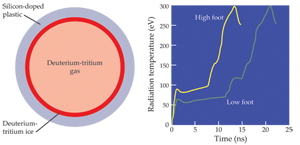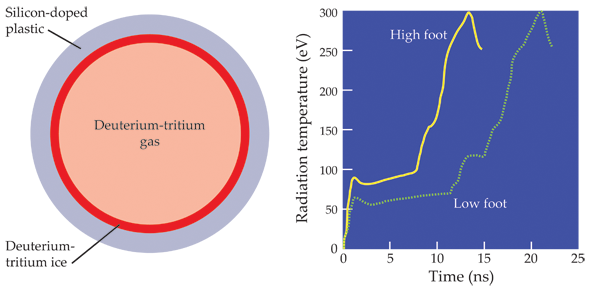Encouraging Signs on the Path to Fusion
For four years, researchers at the National Ignition Facility (NIF) have worked toward an ambitious goal: using powerful lasers to ignite fusion in a tiny target of nuclear fuel. If the fusion reaction releases more energy than the lasers provide—corresponding to a “gain” of greater than 1—NIF could have the makings of a new energy source. But so far, NIF hasn’t been able to pass this gain threshold. And because experiments haven’t matched up with the predictions of simulations, it has been difficult to figure out what to change. Now, researchers (Park et al.) at the Lawrence Livermore National Laboratory, California, where NIF is located, report in Physical Review Letters the first laser ignition experiment that appears to be behaving according to the predictions of current models [1]. The researchers used a different laser pulse shape to heat the target, producing the highest yield of neutrons—and therefore the largest energy output—seen to date. Their result is a major achievement because it gives hope NIF will ultimately find a path to achieving gain greater than .
The NIF experiment consists of a giant laser that delivers a rapid (a few nanoseconds) pulse of about megajoules (MJ) of energy to a spherical target of nuclear fuel (typically deuterium and tritium) the size of a pea (Fig. 1, left). Since the facility began operating in 2009, it has been principally devoted to producing thermonuclear burn and energy gain using a technique called inertial confinement fusion (ICF). The idea is to use the laser to rapidly heat the spherical target. As the outside of the target expands, the fuel is compressed and heated, which drives a fusion reaction generating fast alpha particles and neutrons.
ICF has a long history that dates back to the invention of the laser. The proposal grew out of the thermonuclear weapons program, and in fact, the concept of compression and subsequent heating of the target was kept secret until 1972, when John Nuckolls and researchers at Lawrence Livermore published what is now considered the seminal paper on ICF [2]. In 1982, there was a further revelation that the light energy from the laser could be efficiently converted to thermal x rays inside a small cavity called a hohlraum that contains the target, which in turn could ablate the spherical target to achieve compression [3].
The ICF targets that NIF employs today use these two ideas: indirect drive and compression. Although Nuckolls et al.’s simulations predicted that energy gain could be achieved with a laser pulse of a few nanoseconds carrying as little as kilojoule of energy, NIF was designed to deliver about MJ of energy. The reason is that smaller-scale experiments with lower-energy lasers, combined with numerical simulations, had shown it was unlikely NIF could reach the maximum compression of previous estimates, and more energy would be needed to achieve ignition and burn. The two main culprits limiting compression were nonsymmetrical irradiation by the x rays in the hohlraum and small-scale imperfections in the target, which can never be manufactured to be perfectly spherical. Both of these issues result in the growth of asymmetries and instabilities in the target that become more acute over the course of the implosion and limit compression [4]. (It should be added that NIF’s design was also influenced by a secret US experimental program, called Halite-Centurion, in which x rays from a bomb were used to drive implosions [5,6].)
Experiments conducted at NIF have used indirect drive to attempt to compress and heat the fuel to the conditions needed for ignition and burn [7,8]. Because a long, slow compression requires less energy than a short, fast compression, researchers use a laser pulse that ramps up in intensity in stages. However, the initial design of both the target and the optimal shape of the pulse over time were based on simulations, and recent experiments at NIF haven’t conformed to these theoretical predictions [9]. A target that should, on paper, have ignited, didn’t, and there was no clear reason why. For the most part, researchers have suspected the root cause of the discrepancy is hydrodynamic instabilities during the implosion, which disrupt the target before it can reach the maximum compression predicted by simulations.
It is against this history that Park et al.’s current achievement has to be viewed. The authors have changed the design of the laser pulse shape from its original “low-foot” form—so called because the laser delivers a relatively low x-ray flux to the target for a relatively long time (the foot) and then rapidly ramps up to a higher energy—to a “high foot” temporal profile where the “foot” involves a higher x-ray flux (Fig. 1, right). Motivating the change was a suspicion that, in earlier experiments, the target had blown to bits before it reached the maximum compression predicted by the simulations. One way to prevent this from happening is to deliver more heat to the fuel before the stage in which the main compression occurs, which reduces the total possible compression. However, the neutron yield measured in these new experiments agrees with theoretical predictions and is actually much higher than what was seen in previous experiments that used the low-foot profile.
The results of Park et al. echo the trend of other experiments since the first paper by Nuckolls and co-workers: the compression that can be reached is lower than originally thought. But the new-found agreement between theory and experiment is a major achievement because it allows for the designers to move with more confidence towards their goal of a gain greater than 1. Their experiments also offer another encouraging sign: the fast alpha particles generated by the fusion in the fuel add to the heating provided by compression, thereby further increasing the temperature, the reaction rate, and the total neutron yield. With the laser energy available at NIF, this additional heating is necessary if gain greater than 1 is to be obtained. Park et al.’s experiment shows the first convincing evidence that this alpha particle heating has taken place to any significant degree.
It’s too soon to say if it will ultimately be possible to move to a NIF target design that gives a gain above 1. Researchers have proposed changes to both the design of the target and the design of the laser-pulse that could, on paper, get there. Now that they have seen the self-heating from the alpha particles and have confidence that experiments agree with simulations, they are in the right place to start.
References
- H.-S. Park et al., “High-Adiabat High-Foot Inertial Confinement Fusion Implosion Experiments on the National Ignition Facility,” Phys. Rev. Lett. 112, 055001 (2014)
- J. H. Nuckolls, L. Wood, A. Thiessen, and G. Zimmerman, “Laser Compression of Matter to Super-High Densities: Thermonuclear (CTR) Applications,” Nature 239, 139 (1972)
- J. H. Nuckolls, ”The Feasibility of Inertial-Confinement Fusion,” Phys. Today 34, No. 9, 24 (1982)
- S. E. Bodner, “Rayleigh-Taylor Instability and Laser-Pellet Fusion,” Phys. Rev. Lett. 33, 761 (1974)
- W. Broad, New York Times, 21 March 1988
- R. Evans, “UK Fusion Breakthrough Revealed at Last,” Physics World 3, 23 (2010)
- J. D. Lindl and E. I. Moses, “Special Topic: Plans for the National Ignition Campaign (NIC) on the National Ignition Facility (NIF): On the Threshold of Initiating Ignition Experiments,” Phys. Plasmas 18, 050901 (2011)
- M. J. Edwards et al., ”The Experimental Plan for Cryogenic Layered Target Implosions on the National Ignition Facility—The Inertial Confinement Approach to Fusion,” Phys. Plasmas 18, 051003 (2011)
- M. J. Edwards et al., “Progress Towards Ignition on the National Ignition Facility,” Phys. Plasmas 20, 070501 (2013)
- T. R. Dittrich et al., “Design of a High-Foot High-Adiabat ICF Capsule for the National Ignition Facility,” Phys. Rev. Lett. 112, 055002 (2014)





